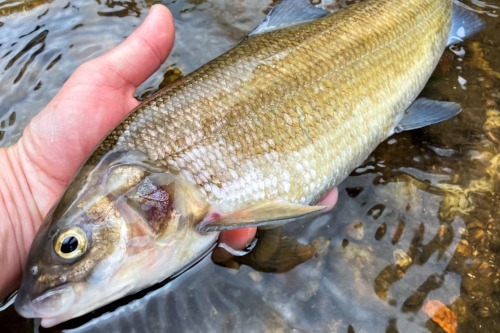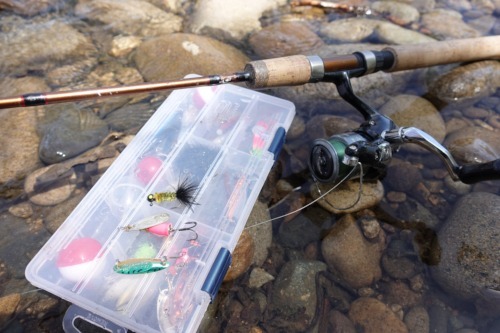 Never say “Ahh, it’s just a whitefish” again. Looking for an excuse to wader up and tie on some flies or jigs? Look no further than one of Idaho’s native unsung heroes: the mountain whitefish. Mountain whitefish, the disco ballish, tight-lipped river dwellers that populate a majority of Idaho’s streams and rivers, are often overlooked and underhooked. In the words of Rodney Dangerfield, they “get no respect,” but where do these unfavorable allegations come from, and are they even accurate?
Never say “Ahh, it’s just a whitefish” again. Looking for an excuse to wader up and tie on some flies or jigs? Look no further than one of Idaho’s native unsung heroes: the mountain whitefish. Mountain whitefish, the disco ballish, tight-lipped river dwellers that populate a majority of Idaho’s streams and rivers, are often overlooked and underhooked. In the words of Rodney Dangerfield, they “get no respect,” but where do these unfavorable allegations come from, and are they even accurate?
Before we get into the benefits of whitefishing, there are a few misconceptions associated with the species that need to be cleared up.
It’s fair to say that many passionate anglers who’ve seen their rod tip dip, thinking they have a feisty trout on the other end, only to reel in something else, have muttered the words: “Ahh. It’s just a whitefish.”
Blasphemy.
That whitefish on the end of your line has earned its stripes in Idaho, a fish that has called these waters home for thousands of years. While they might not be as charismatic as the rainbow trout, regarding them as “trash fish” or “bottom feeders” is nothing more than an insult and could not be further from the truth.
“Mountain whitefish are a fun species to target, especially in late winter when trout and other mountain stream species feed less,” said Joe Kozfkay, Fish and Game’s State Fisheries Manager. “Anglers have a pretty cool opportunity to catch these fish during this season, a lost tradition that often gets forgotten or overlooked.”

The late Ralph Anglen, who wrote the weekly fishing column in the Bonners Ferry Herald from 1973 right up to 2004, when he passed, extoled the virtues of whitefish, fun to catch, he said, and great to eat, especially smoked. You can find 50 years of “Anglin’ with Anglen” columns at the Boundary County Museum, and you won’t have to dig far to read and learn of his love for this wonderful fish.
Whitefish tend to hunker down in deeper parts of the river. Their placement in the water, combined with their mouth’s small, puckered appearance, often give anglers the impression they’re docile and won’t go after normal-sized tackle. Despite their small mouths, whitefish can still be just as voracious as their trophy neighbors.
In most cases where the two species coexist, Fish and Game has found that whitefish commonly outnumber trout by 5-10 times.
But if whitefish are more closely related to trout, does that mean they’re outcompeting their distant cousins?
Not according to stream surveys.
Some anglers might have concerns about the whitefish/trout dynamic in mountain rivers and streams. Fish and Game fish managers have been studying this relationship for decades and learned from research that trout populations can be affected by flow, habitat conditions or even harvest, but competition with whitefish is not a real concern. In the long term, they found the limiting factor for trout populations in good habitat is often winter survival, not competition from whitefish.
With whitefish populations as robust as they are, there’s only one thing left to do: go fishing.
Whitefish check a lot of the boxes for stream fishing in winter and early spring (or any other time of year).
They’re plentiful, bag limits are high and they’re found in rivers and streams (and some lakes) all over the state. You can pretty much see them shimmering when the water’s low. They are more aggressive than other fish during winter. And they slurp up a fly or bait just as readily as a trout would.
So what’s the hold up?
 For starters, it shouldn’t be your tacklebox. Whitefish will generally entertain the same buffet of bait, flies and lures that your run-of-the-mill rainbow trout would. If you’re accustomed to trout fishing in the warmer months, chances are your setup will work just fine for winter-season whitefish. You might need some thicker waders, but you won’t have to break the bank on custom flies or lures.
For starters, it shouldn’t be your tacklebox. Whitefish will generally entertain the same buffet of bait, flies and lures that your run-of-the-mill rainbow trout would. If you’re accustomed to trout fishing in the warmer months, chances are your setup will work just fine for winter-season whitefish. You might need some thicker waders, but you won’t have to break the bank on custom flies or lures.
Whitefish will readily take a single salmon egg, chunk of worm or other bait, such as maggots. They will also take artificial flies, including dry flies.
Remember that, compared to trout, whitefish have smaller mouths. A good rule of thumb might be sizing down your flies or lures. They’re probably not going to get their mouths around a #2 woolly bugger or a big bait hook with a glob of nightcrawler. Smaller is better.
Recall that whitefish also tend to be hugging the bottom of the river or holed up in pools. You might entice one up to the surface to take a dry fly, but more often than not you’re going to want to drop your fly or lure right in front of their nose.
Try tossing a weighted nymph — either caddis, midge or stonefly — through slow-to-medium moving water during the warmest part of the day. Look for water streaked with foam and drift your line down with the current. If your smaller fly doesn’t have enough weight to get it down, or if the water is moving too quickly, you can always add a split-shot weight to your line to help sink your fly or lure. You can also achieve this with a double-dropper rig, or a heavy fly (like a beadhead woolly bugger) with a smaller weighted fly (like a zebra midge) tied about 12-18 inches back.
Not a fly fisherman? No worries. You can achieve the same outcome with a conventional spin rod and tacklebox. Common baits for whitefishing can include maggots, salmon eggs (also a reliable fly pattern) or chunks of worm.
Mountain whitefish gather in large schools, unlike trout, so where there’s one there’s usually several more.
Hot Tip:: Whitefish have small, delicate mouths and are less aggressive when taking a fly. Try using a strike indicator, or a plastic bobber, four to six feet from your hook or fly. A well-placed strike indicator will give you a nice indication (as the name implies) when a whitefish flirts with your fly.
Fish and Game offers a generous daily bag limit on whitefish, usually 25 fish per day. Be sure to check the rules, though, on whichever fishery you plan on visiting to be safe.
Anglers can capitalize on the abundance of whitefish and their liberal bag limits in a number of ways, including the supper table. Despite being filled with more bones than a prehistoric buffalo jump, mountain whitefish can prove to be excellent table fare worthy of any angler’s palette.
Whitefish can get real big, real quick. In their first three to four years, a whitefish commonly grows to 10-12 inches in length. A mature whitefish can exceed even that, oftentimes in the 12-16-inch range. And the state catch-and-release record caught in 2022 came in at a whopping 21.5 inches long!
That’s a lot of meat, even on a relatively bony fish. And, an under-utilized food source.
The meat is not dissimilar from that of trout. It’s light and mildly fishy tasting, but yes, is incredibly bony — a premise that often causes anglers to pass them up.
The most popular option is to smoke them in your backyard smoker. Smoking whitefish is one of the easiest ways to ensure your meal is bone-free. In the age of the internet, there are hundreds of smoked whitefish recipes out there worthy of your time. Do some research, experiment. See what works and what doesn’t. And above all else, have fun fishing.

I enjoyed this article. I like the new look of the web site too!